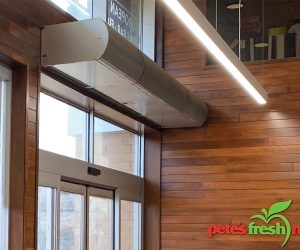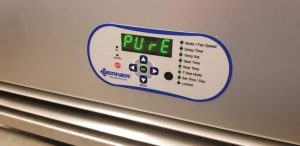— By Phil Thomas —
Air curtains with COVID-19 disinfection: How to present stores and restaurants that customers are confident to enter during a pandemic.
Confidence is one game-changing factor restaurants and retailers must restore to regain patrons and employees amid the COVID-19 pandemic. Facility operators should take sanitization actions and promote them as part of their COVID-19 response.

Phil Thomas, Berner International
Outdoor dining, curbside service and pickup, masks, shields and social distancing have instilled some confidence and brought back a few patrons that have shopped online or eaten at home since mid-March.
Air transmission of COVID-19 is what shatters confidence. Airborne COVID-19 particles can remain suspended for hours and easily spread from patron to patron, according to a popular Centers for Disease Control and Prevention (CDC) article. The CDC studied a restaurant in Guangzhou, China, where several diners were infected with SARS-CoV-2 on January 24, which causes COVID-19.1
Deactivating potentially-infecting airborne COVID-19 droplets inside the restaurant or retailer’s space is one way to boost confidence and prompt the return of patrons and employees. As the season shifts to colder weather and restaurants and retailers seek ways to safely operate indoors, addressing the airborne transmission concerns of COVID-19 indoors will be paramount.
That strategy is now available with a recent introduction of air purification systems on doorway air curtains that distribute ions capable of deactivating COVID-19 and other viruses in the air and on surfaces.
 Air curtains have been mounted above restaurant and retail doorways for decades to save heating or cooling energy costs and to protect the comfort of building occupants by separating indoor and outdoor environments when the door is open. Air curtains also prevent the infiltration of flying insects, dirt and vehicle emissions. Preventing flying insect infiltration without chemicals is why they’re mounted on every California food service location’s back shipping door for sanitation compliance with the California Health and Safety Code (CHSC).2
Air curtains have been mounted above restaurant and retail doorways for decades to save heating or cooling energy costs and to protect the comfort of building occupants by separating indoor and outdoor environments when the door is open. Air curtains also prevent the infiltration of flying insects, dirt and vehicle emissions. Preventing flying insect infiltration without chemicals is why they’re mounted on every California food service location’s back shipping door for sanitation compliance with the California Health and Safety Code (CHSC).2
Now air curtains offer a unique opportunity with integrated virus deactivation at main entrances. One very exciting disinfection method is needlepoint bipolar ionization (NPBI) technology, which has been third-party surface tested by Innovative Bioanalysis of Cypress, California, to neutralize airborne viruses, including SARS CoV-2, at a 99.4% success rate during 30-minute exposures.3 NPBI also disinfects mold, mildew, allergens, bacteria and other biological contaminants using an ionization process that’s Environmental Claim Validated through UL-2998 for zero ozone emission and byproducts-free.
 NPBI is viewed as a proactive remedy, because its ions aggressively seek airborne contaminants. NPBI creates positively and negatively-charged ions. An air curtain outfitted with an NPBI module in its supply airstream distributes the ions throughout the space that the exterior doorway serves. These ions proactively seek and electrically attach to microscopic airborne and surface particulate contaminants. The positive and negative ions break down gases such as VOCs and odors, while also pulling hydrogen out of viruses, bacteria and mold that deactivates or kills them. Additionally, the polarized particles’ electrical attraction and subsequent agglomeration of particles potentially facilitates either a drop onto surfaces or entrapment in the air curtain intake’s MERV 8 filter.
NPBI is viewed as a proactive remedy, because its ions aggressively seek airborne contaminants. NPBI creates positively and negatively-charged ions. An air curtain outfitted with an NPBI module in its supply airstream distributes the ions throughout the space that the exterior doorway serves. These ions proactively seek and electrically attach to microscopic airborne and surface particulate contaminants. The positive and negative ions break down gases such as VOCs and odors, while also pulling hydrogen out of viruses, bacteria and mold that deactivates or kills them. Additionally, the polarized particles’ electrical attraction and subsequent agglomeration of particles potentially facilitates either a drop onto surfaces or entrapment in the air curtain intake’s MERV 8 filter.
During open door cycles, the air curtain performs the traditional environmental separation while also purifying the air with ions. When the door closes, the air curtain’s digital controller automatically transitions it to an air purifier mode for continuous NPBI ion distribution throughout the space by switching to a quiet, low speed. The air purifier setting distributes a minimum-ion density of 787 – ions/inch2 (2,000 ions/cm2) within a minute for reliable pathogen disinfection of roughly 600 square feet of the interior space surrounding the entrance. On the air purification nighttime mode, the air curtain runs at a significantly higher velocity to provide optimum ion density. This de-stratifies the room air and comprehensively fills the entire space with air purifying ions prior to occupancy periods.
An added NPBI benefit is its capability to neutralize odors caused by VOCs and other odorous contaminants, which can be created by food preparation in restaurants or retail store product chemical off-gassing. The same ionization process of electrical ion attraction also removes VOCs.
Even when COVID-19 hopefully disappears someday, an air curtain that continually purifies the air and provides superior indoor air quality will subliminally attract customers with its healthy environment.
References:
1 https://wwwnc.cdc.gov/eid/article/26/7/20-0764_article#tnF1
— Phil Thomas is product manager at Berner International, a New Castle, Pennsylvania-based air curtain manufacturer. Thomas is a 25-year veteran of the product development industry with 15 years at Berner.
